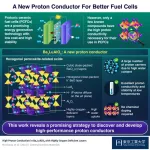(Press-News.org) The discovery of Ba2LuAlO5 as a promising proton conductor paints a bright future for protonic ceramic fuel cells, report scientists from Tokyo Tech. Experiments show that this novel material has a remarkably high proton conductivity even without any additional chemical modifications, and molecular dynamics simulations reveal the underlying reasons. These new insights may pave the way to safer and more efficient energy technologies.
When talking about sustainability, the ways in which a society generates energy are some of the most important factors of consideration. Eager to eventually replace traditional energy sources such as coal and oil, scientists across the world are trying to develop environmentally friendly technologies that produce energy safely and more efficiently. Among them, fuel cells have been steadily gaining traction since the 1960s as a promising approach to producing electricity directly from electrochemical reactions.
However, typical fuel cells based on solid oxides have a notable drawback in that they operate at high temperatures, usually over 700 °C. That is why many scientists have focused on protonic ceramic fuel cells (PCFCs) instead. These cells use special ceramics that conduct protons (H+) instead of oxide anions (O2−). Thanks to a much lower operating temperature in the range of 300 to 600 °C, PCFCs can ensure a stable energy supply at a lower cost, compared to most other fuel cells. Unfortunately, only a few proton-conducting materials with reasonable performance are currently known, which is slowing down progress in this field.
To address this challenge, a team of researchers, including Professor Masatomo Yashima from Tokyo Institute of Technology (Tokyo Tech) in Japan, has been on the lookout for good proton conductor candidates for PCFCs. In their latest study, published in Communications Materials, the team reported the remarkable properties of Ba2LuAlO5, a new hexagonal perovskite-related oxide that has provided interesting insights into proton conduction.
Prof. Yashima and colleagues discovered Ba2LuAlO5 while focusing on finding compounds with a lot of intrinsic oxygen vacancies. This was motivated by the results of previous studies highlighting the importance of these vacancies in proton conduction. Experiments on Ba2LuAlO5 samples revealed that this material has a high proton conductivity in its bulk at low temperatures—its conductivity was 10‒2 S cm‒1 at 487 °C and 1.5×10‒3 S cm‒1 at 232 °C—even without additional chemical refinements such as doping.
Afterwards, the team sought to find out the underlying reasons for this property. Through molecular dynamics simulations and neutron diffraction measurements, they learned two important characteristics of Ba2LuAlO5. The first is that this oxide absorbs a lot of water (H2O), compared to other similar materials, to form Ba2LuAlO5.0.5H2O. This large water uptake, which occurs within two opposing layers of AlO4 tetrahedra, is made possible by a high number of intrinsic oxygen vacancies in the hexagonal close-packed h’ BaO layers. In turn, the oxide’s higher water content increases its proton conductivity through various mechanisms, such as higher proton concentration and enhanced proton hopping.
The second important characteristic is related to how protons move through Ba2LuAlO5. Simulations revealed that protons diffuse mainly along the interfaces of LuO6 layers, which form cubic close-packed c BaO3 layers, rather than through the AlO4 layers. This information could be critical in the search for other proton conducting materials, as Prof. Yashima explains: “Our work provides new design guidelines that open up unexplored avenues for the development of higher-performance proton conductors in the future.”
The researchers expect to find other proton-conducting materials based on Ba2LuAlO5 in upcoming studies. “By modifying the chemical composition of Ba2LuAlO5, further improvements in proton conductivity can be expected,” comments Prof. Yashima, “For example, the perovskite-related oxide Ba2InAlO5 may also exhibit high conductivity since its structure is quite similar to that of Ba2LuAlO5.”
Overall, the future of PCFCs seems bright and, by extension, so does the future of sustainable energy generation technologies.
###
The Yashima Research Group
Discovering Hidden Order in Disordered Crystals | Tokyo Tech News
Novel Oxychloride Shows High Stability and Oxide-Ion Conduction through Interstitial Oxygen Site | Tokyo Tech News
Elucidating the Mechanism of High Proton Conduction to Develop Clean Energy Materials | Tokyo Tech News
Fueling the Future with New Perovskite-related Oxide-ion Conductors | Tokyo Tech News
In the Spotlight: Successful Synthesis of Perovskite Visible-Light-Absorbing Semiconductor Material | Tokyo Tech News
New Ba7Nb4MoO20-Based Materials with High Oxygen-Ion Conductivity Could Open Sustainable Future | Tokyo Tech News
New High Proton Conductors with Inherently Oxygen Deficient Layers Open Sustainable Future | Tokyo Tech News
Getting through the bottleneck—A new class of layered perovskite with high oxygen-ion conductivity | Tokyo Tech News
Apatite-Type Materials without Interstitial Oxygens Show High Oxide-Ion Conductivity by Overbonding | Tokyo Tech News
Discovery of a new structure family of oxide-ion conductors “SrYbInO4” | Tokyo Tech News
About Tokyo Institute of Technology
Tokyo Tech stands at the forefront of research and higher education as the leading university for science and technology in Japan. Tokyo Tech researchers excel in fields ranging from materials science to biology, computer science, and physics. Founded in 1881, Tokyo Tech hosts over 10,000 undergraduate and graduate students per year, who develop into scientific leaders and some of the most sought-after engineers in industry. Embodying the Japanese philosophy of “monotsukuri,” meaning “technical ingenuity and innovation,” the Tokyo Tech community strives to contribute to society through high-impact research.
https://www.titech.ac.jp/english/
END
Scientists from the UCLA Jonsson Comprehensive Cancer Center have developed a new method to bioprint miniature tumor organoids that are designed to mimic the function and architecture of real tumors. The improved process allows researchers to use an advanced imaging method to study and analyze individual organoids in great detail, which can help researchers identify personalized treatments for people with rare or hard-to-treat cancers.
The method is described in the journal Nature Communications.
“Tumor organoids have become fundamental tools to ...
The addition of ‘trust’ and ‘distrust’ buttons on social media, alongside standard ‘like’ buttons, could help to reduce the spread of misinformation, finds a new experimental study led by UCL researchers.
Incentivising accuracy cut in half the reach of false posts, according to the findings published in eLife.
Co-lead author, Professor Tali Sharot (UCL Psychology & Language Sciences, Max Planck UCL Centre for Computational Psychiatry and Ageing Research, and Massachusetts Institute of Technology) said: “Over the past few years, the spread of misinformation, or ‘fake news’, has skyrocketed, ...
One of the challenges in treating burn victims is the frequency of dressing changes, which can be extremely painful.
To bring relief to this and other problems, University of Waterloo researchers have created a new type of wound dressing material using advanced polymers. This new dressing could enhance the healing process for burn patients and have potential applications for drug delivery in cancer treatment as well as in the cosmetic industry.
"To treat burn victims, we can customize the shape using a 3D printer, secondly, the material has fine-tuned surface adhesion, which is a key feature", said Dr. Boxin Zhao, a professor in Waterloo's Department of ...
Chatbots are increasingly becoming a part of health care around the world, but do they encourage bias? That’s what University of Colorado School of Medicine researchers are asking as they dig into patients’ experiences with the artificial intelligence (AI) programs that simulate conversation.
“Sometimes overlooked is what a chatbot looks like – its avatar,” the researchers write in a new paper published in Annals of Internal Medicine. “Current chatbot ...
An international research team from Tanzania and Japan created a smartphone app and conducted a pilot study of how the app might be used to improve midwives’ knowledge and skills in Tanzania. Their study focused on the app’s potential effects on the learning outcomes of midwives and birth preparedness of pregnant women in Tanzania.
The team’s work is published in the journal PLOS ONE on March 31, 2023.
“The smartphone app for midwives showed significant improvements in their learning outcomes, leading to better birth preparations for pregnant women in Tanzania. This study highlights the potential of leveraging technology ...
An international team of astronomers has detected complex organic molecules in the most distant galaxy to date using NASA’s James Webb Space Telescope.
The discovery of the molecules, which are familiar on Earth in smoke, soot and smog, demonstrates the power of Webb to help understand the complex chemistry that goes hand-in-hand with the birth of new stars even in the earliest periods of the universe’s history. At least for galaxies, the new findings cast doubt on the old adage that where there’s smoke, there’s ...
Children who are breastfed for longer appear to be more likely to gain slightly better results in their school GSCEs at age 16 compared with non-breastfed children, suggests a study published online in the journal Archives of Disease in Childhood.
The evidence of improved educational outcomes is still apparent even when various factors are taken into account such as people’s socio-economic status and their parents’ intelligence.
Previous studies have suggested that children breastfed for longer have improved educational outcomes later in life. However these are relatively scarce, and ...
A method of care involving skin-to-skin contact between a mother and her prematurely born or low birth weight baby appears to impact the child’s chances of survival significantly, suggests a study published online in the journal BMJ Global Health.
Starting the intervention within 24 hours of birth and carrying it out for at least eight hours a day both appear to make the approach even more effective in reducing mortality and infection, researchers found.
The method of care known as ‘Kangaroo mother care’ (KMC) involves an infant being carried, usually by the mother, in a sling with skin-to-skin contact ...
Defibrillators are being used in just one in ten cardiac arrests where the lifesaving devices are available, according to new research presented at the British Cardiovascular Society Conference in Manchester.
The research drew upon data from the East of England Ambulance Service and The Circuit, the national defibrillator network developed by the British Heart Foundation (BHF). The Circuit maps the location of defibrillators across the whole of the UK, so that emergency services can direct bystanders to the nearest defibrillator in the event of ...
Patients with heart disease could benefit from less extensive interventions thanks to cutting-edge technology that creates 3D computer models of blood flow through the heart's arteries, according to research presented at the British Cardiovascular Society in Manchester.
When the research team trialled the VIRTUHeartTM technology with doctors treating heart attack patients, they found that using it would have changed the treatment of more than 20 per cent of patients. In many cases, it would have led to fewer patients undergoing an invasive procedure such ...





